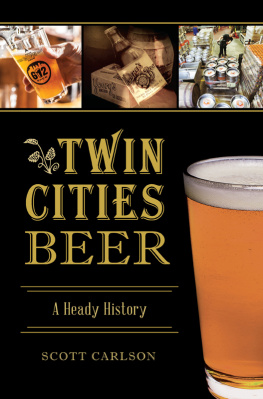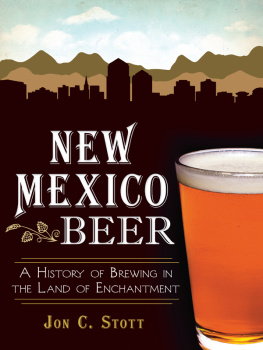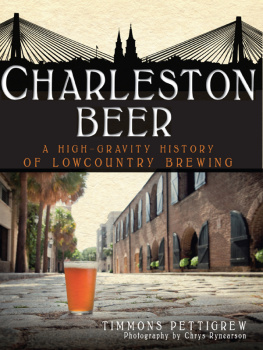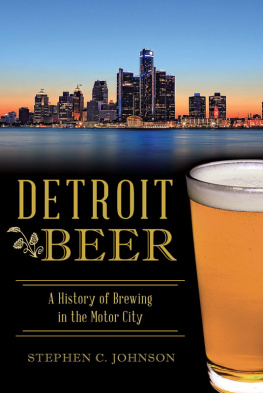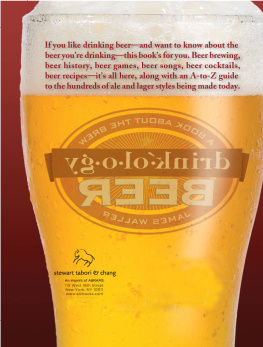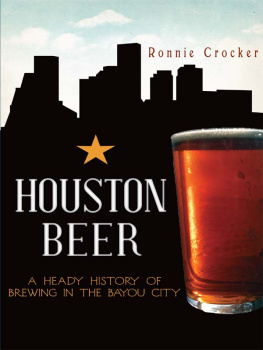


Published by American Palate
A Division of The History Press
Charleston, SC
www.historypress.com
Copyright 2018 by Scott Carlson
All rights reserved
First published 2018
e-book edition 2018
ISBN 978.1.43966.436.0
Library of Congress Control Number: 2018932091
print edition ISBN 978.1.46713.705.8
Notice: The information in this book is true and complete to the best of our knowledge. It is offered without guarantee on the part of the author or The History Press. The author and The History Press disclaim all liability in connection with the use of this book.
All rights reserved. No part of this book may be reproduced or transmitted in any form whatsoever without prior written permission from the publisher except in the case of brief quotations embodied in critical articles and reviews.
To my mother, Joan Carlson, who instilled in me a love of learning.
To my wife, Betsy (Becker) Carlson, my faithful, supporting and loving companion.
To all the homebrewers who have gone on to start up their own commercial microbreweries.
CONTENTS
PREFACE
In the last few years, the Twin Cities have witnessed an explosion of new craft beer breweries and brewpubs dotting the business landscape. As of the publication of this book, there are more than fifty microbreweries up and running in the St. PaulMinneapolis region. The trend has been buoyed by changes in state laws that now give smaller-scale brewers the latitude to set up taprooms on their premises so they can easily and immediately generate revenue to support their businesses rather than being bound first to get expensive distribution systems in place.
Meanwhile, the burgeoning numbers of microbreweries also have been bolstered by a growing public acceptance, willingness and desire to stray beyond big-name, mass-produced brands and dabble in the delight of expanding taste buds into the craft beer craze.
But the surging interest by Twin Citians in craft beers and microbreweries is not occurring in a mystic vacuum. The simple truth is the Twin Cities have a rich tradition of brewing and breweries that dates back to the mid-1800s. We have been home to some of the best-known brands in Americafrom Hamms and Schmidts to Grain Belt and Olympia. Other names are associated with the beer brewing traditionGluek, Yoerg, Brueggemann and Schell. Today, we see remnants of those past majestic beer brewers, their mass production facilities starting to take on new life with, in some cases, distilleries, microbreweries, aquapond production, commercial offices and residential apartments.
In Minneapolis, the Grain Belt Beer sign sits just hundreds of feet outside of De La Salle High School on Nicollet Island, visible to thousands of commuters who cross the Mississippi River via the Hennepin Avenue Bridge every day. For more than seventy-five years, the forty-foot-tall sign, with its steely wires hoisting the familiar bottle cap, has been welcoming western travelers into downtown Minneapolis.
Brewing in Minneapolis dates back to the 1800s with the Minneapolis Brewing Company, which introduced Grain Belt beer into the city in 1893. The golden ale was brewed in the original Grain Belt brewery until 1976. After a series of other owners, August Schell Brewing Company took over in 2002, and Grain Belt was produced out of New Ulm, Minnesota, until 2015. The sign remains a fixture of Minneapolis, the dominant domicile for Minnesota brewing.
Some of the earliest records show that German-born Gottlieb Gluek started the Mississippi Brewery in 1857 at Marshall Street and Twenty-Second Avenue NE along the river just north of the city. The brewery burned to the ground in 1880 and spurred Glueks sons creation of the Gluek Brewing Company, which survived Prohibition but was sold and dissolved in 1964. Today, the Gluek label has been revived and is available in general distribution beyond the longtime Minneapolis restaurant of the same name.
Minneapolis has still successfully established its own identity as a welcomingand consuminghome for microbrewers, whether that be in ones kitchen or in a cohorts bar. Although only two of Minnesotas five biggest breweries are in Minneapolis, more than twenty microbreweries have established themselves in the city limits and immediate suburbs, and their beers are fixtures in the one-hundred-plus bars found around the city.
Big players in Minneapolis like Surly Brewing Company produce thousands of barrels per year and are easy to find. But quaint, unique bars like Republicwhich serves more than twenty taps of local brews you maybe knew existed or tastedhelp cultivate the distinctive microbrewery scene along the Mississippi Rivers northernmost big metro community.
Meanwhile, in neighboring St. Paul, the Saintly City has a long history of breweries as well. That tradition dates back to the early 1800s and the days of Pierre Pigs Eye Parrant, an early fur trapper/settler who was a part-time bootlegger and established his own tavern along the banks of the Mississippi River. And in 1848, William Yoerg put down roots for a brewery along St. Pauls Mississippi River bluffs, making it the oldest commercial brewery in the state. With the drilling of artesian wells, two major breweries sprang up in St. Paulthe Jacob Schmidt brewery (in St. Pauls West Seventh community) and the Hamms brewery (tucked in on the south end of St. Pauls East Side).
Currently, Minnesota is sixteenth out of the fifty states in the number of breweries and craft breweries per capita, with most of the states sixty-plus brewhouses residing in the Minneapolis area.
Of the craft beer phenomenon, Bad Weather Brewing co-founder Zac Carpenter said, I look at craft beer as more than a product on shelves. Craft beer is a device that fosters community and socialization. Just about anyone can find something to talk about while having a beer.
St. Paul and its suburbs also are getting in on the action with the establishment of such microbrewers as Barley Johns Brew Pub, Flat Earth Brewing and Pour Decisions Brewing Company in Roseville (now renamed and operating as Bentbrewstillery).
My own recollections of the Twin Cities breweries were first as a boy who loved following the new Minnesota Twins in the 1960s and knew that Hamms, with its iconic bear and familiar advertising jingle (more about that later in this book), was a major sponsor of the baseball teams TV and radio broadcasts. Nestled in St. Pauls Italian district on the citys East Side, my nostrils would be filled with the smell of brewing from the Hamms plant when my parents would take my brother and me for spaghetti dinners at the old Genos spaghetti joint.
Later, as an adult, I was part of the team of St. Paul Pioneer Press reporters who chronicled the closing of the Schmidt plant and later the Olympia plant (formerly Hamms brewery). I witnessed firsthand how the plant closings hurt employees, many of whom were second- and third-generation family brewery workers.
In pulling together this book over the past year, I chose not to discuss the process of brewing beer or examine the brewing history across all of Minnesota. Thats already been ably done in such tomes as Doug Hoversons fine book Land of Amber Waters: The History of Brewing in Minnesota (University of Minnesota Press, 2007). Rather, I endeavored to give you, the reader, a snapshot of the Twin Cities rich history of brewing and breweries, yesterday and today.
Next page
